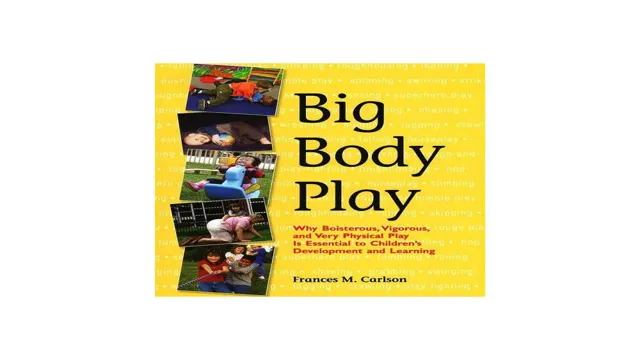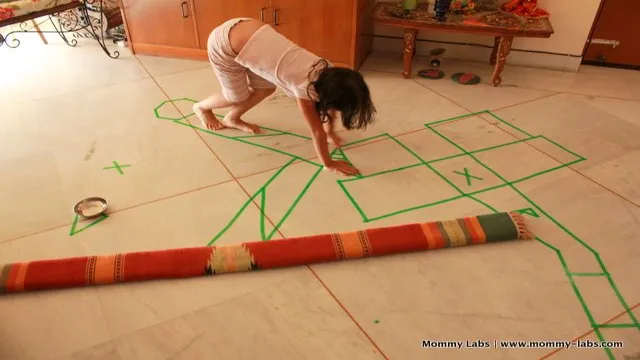Big body play is often misunderstood by adults who see it as roughhousing or horseplay that can lead to injuries or aggression. However, big body play is a crucial aspect of childhood development that helps children learn about their bodies, boundaries, and social interactions. It involves physical movements like jumping, climbing, crawling, rolling, and wrestling that allow children to explore their physical capabilities and experiment with different ways of moving.
As children engage in big body play, they also learn how to negotiate and communicate with peers, read social cues, and regulate their emotions. In this blog, we will dive deeper and explore the meaning of big body play and how it benefits children’s overall development.
Explaining Big Body Play
Big body play can be defined as a type of play where children use their bodies to move, touch, and interact with their surroundings and peers. This type of play involves roughhousing, wrestling, jumping, running, and pushing, which may seem aggressive or scary to adults, but it is actually an important way for kids to learn about their physical capabilities, test boundaries, and build social connections. Big body play is also beneficial to children’s overall development as it improves their motor skills, coordination, strength, and balance.
However, it is important for adults to observe and supervise big body play to ensure that it remains safe and respectful for all participants. By understanding the purpose and benefits of big body play, adults can support and encourage children to engage in this type of play in a safe and positive way.
What Exactly is Big Body Play?
Big Body Play, also known as rough-and-tumble play, is an important type of activity for young children. It involves physical play such as climbing, wrestling, rolling, and jumping, and provides children with opportunities to explore and experiment with their bodies in a safe and controlled environment. Big Body Play is not just about physical activity; it also helps children develop important social and emotional skills such as taking turns, sharing, and communication.
Through Big Body Play, children learn how to regulate their emotions and behavior and how to negotiate with others, skills that are essential for building strong relationships later in life. Overall, Big Body Play is an essential element of early childhood development that helps children grow and thrive while having fun and being active.

Why is Big Body Play Important?
Big body play, also known as rough and tumble play, is important for the development of children. This type of play helps children develop vital skills such as self-regulation, social skills, and physical development. When children engage in big body play, they learn to control their impulses, which is essential for their emotional and mental development.
Furthermore, big body play allows children to develop their social skills by learning how to play cooperatively, resolve conflicts, and communicate effectively with their peers. Additionally, this type of play helps children improve their physical development by building their strength, coordination, and balance. It is critical to incorporate big body play in children’s daily routine, whether it be at home or at school, to promote their overall development and well-being.
Examples of Big Body Play
Big body play is defined as any form of physical activity that involves using one’s body in a playful and energetic manner. This can include jumping, running, wrestling, chasing, and rolling around. Big body play is typically seen in young children, but it can also be enjoyed by adults.
Some examples of big body play include tag, dodgeball, hide-and-seek, and playing on playground equipment such as swings and slides. Big body play is important for children as it helps them develop gross motor skills, balance, coordination, and socialization skills. It can also be a fun and healthy way for adults to stay active and release stress.
So next time you find yourself feeling playful, go ahead and engage in some big body play!
Organized Sports and Games
Organized sports and games are a great way to encourage big body play and physical activity. One example of a big body play activity that can be done through organized games is tag. Tag can be played in a variety of ways such as freeze tag or tunnel tag, and it is a fun way to get children running, jumping, and dodging while using their big muscles.
Another example of big body play that can be incorporated into organized sports is a game of basketball. Basketball is a great sport for developing hand-eye coordination and gross motor skills for the children as it requires running, jumping, and throwing and catching. Organized sports provide children with an opportunity to engage in play with peers while learning new skills and physical activities.
These activities help children to develop their muscles and practice their social skills while enjoying themselves.
Unstructured Play and Exploration
Unstructured play and exploration are crucial for a child’s overall development and well-being. One type of play that children love engaging in is Big Body Play. These are physical games that primarily involve the use of their bodies, such as running, climbing, wrestling, and chasing.
Big Body Play helps promote the development of spatial awareness, body coordination, and gross motor skills in children. It also helps build their social skills as they learn to interact and communicate with their peers. Some examples of Big Body Play include playing tag, racing, hopping, and jumping.
These activities promote a sense of accomplishment and self-confidence, providing children with a sense of control over their bodies. Moreover, Big Body Play is a fun and enjoyable way for children to engage in physical activity that is essential for their growth and development.
Playful Roughhousing
Big Body Play As parents, it’s natural to want to protect our kids from harm. But sometimes, roughhousing can actually be beneficial for children! Big body play, also known as roughhousing, involves playful physical activity that can help strengthen bonds between children and their caregivers. Examples of big body play include tickling, wrestling, and spinning around in circles.
Of course, it’s important to set boundaries and make sure everyone involved feels comfortable. When done safely and respectfully, big body play can help children develop confidence, social skills, and physical coordination. So the next time your little one wants to roughhouse, don’t be afraid to join in on the fun!
Benefits of Big Body Play
Big Body Play refers to the type of play where young children use their entire body, using all of their large muscles to engage in physical activity. This can include running, jumping, climbing, and wrestling, among other activities. Such play is important for young children, as it helps them develop gross motor skills, physical strength, and balance.
Additionally, it also helps to improve their social and emotional development, as children learn how to communicate and interact with each other through cooperative play. Big Body Play is not just important for young children’s development, but also for their mental and emotional well-being. It helps children to burn off excess energy and develop a strong body image, which can foster self-confidence and self-esteem.
Ultimately, through engaging in Big Body Play, children learn to enjoy physical activity and develop life-long habits of staying active and healthy.
Physical and Emotional Development
Big body play, which involves active and physical play such as running, climbing, and jumping, is an essential part of children’s physical and emotional development. Not only does it improve children’s gross motor skills, balance, and coordination, but it also promotes social skills such as teamwork, communication, and problem-solving. Additionally, big body play allows children to release pent-up energy and emotions in a safe and constructive manner, reducing stress and anxiety levels.
When children engage in big body play, they experience a burst of endorphins, which boost their mood and make them feel happy. Moreover, big body play can help children develop self-confidence, a sense of accomplishment, and resilience. Overall, incorporating big body play into children’s daily routines is crucial for their growth and well-being.
Social and Cognitive Development
Big body play is an essential part of children’s social and cognitive development. This type of play involves children using their entire bodies to explore and engage with their environment. Benefits of big body play include improved physical development and coordination, as well as increased self-confidence and independence.
Through this type of play, children learn how to regulate their emotions and communicate effectively with others. Furthermore, big body play often involves social interaction, allowing children to develop important social skills such as cooperation, negotiation, and conflict resolution. Overall, encouraging children to engage in big body play is critical in promoting their overall development and wellbeing.
Tips for Safe and Fun Big Body Play
Big body play is a form of physical activity that involves using your body weight and strength to engage with another person. It’s a great way to build trust, cooperation, and communication skills while also getting in a good workout. However, as with any physical activity, it’s important to practice safety measures to prevent injury.
Some tips for safe and fun big body play include warming up before you start, establishing clear rules and boundaries with your partner, communicating throughout the activity to ensure you’re both comfortable, and being aware of your own limitations and those of your partner. Remember, the goal of big body play is to have fun and build connections, so don’t be afraid to take breaks or switch up the activity if you or your partner begin to feel uncomfortable. By following these guidelines, you can enjoy all the benefits of big body play without putting yourself or others at risk.
Conclusion
In conclusion, big body play can be defined as the primal and exhilarating act of kids using their physical bodies to explore, create, compete, and connect with their environment and peers. From climbing trees to tackling each other, from building forts to playing tag, from dancing wildly to pretending fiercely, from laughing loudly to sweating profusely, big body play is not only a fun and free form of entertainment, but also a vital means of promoting physical, cognitive, social, and emotional development. So, if you see a group of children engaging in big body play, don’t just dismiss them as noisy or risky, but rather appreciate their natural instincts and let them unleash their inner beasts and beauty.
Because, just like the great philosopher Plato once said, “You can discover more about a person in an hour of play than in a year of conversation.”
FAQs
What is big body play in early childhood?
Big body play involves physical movements like running, jumping, climbing, crawling, and rough-and-tumble play that support children’s physical development and social-emotional wellbeing.
Why is big body play important for children’s development?
Big body play promotes gross motor skills, body awareness, spatial relationships, balance, and coordination. It also helps build self-confidence, social skills, problem-solving abilities, and emotional regulation.
How can parents and teachers encourage big body play in children?
Parents and teachers can provide safe and stimulating environments that allow children to engage in big body play, such as playgrounds, parks, gyms, or dance studios. They can also model and support positive behaviors, establish rules and boundaries, and offer opportunities for children to practice different forms of physical play.
What are some potential risks and challenges associated with big body play?
While big body play can be beneficial for children, it can also pose some risks and challenges, such as injuries, conflicts, misunderstandings, and exclusion. It is important for adults to supervise and intervene when necessary, communicate effectively with children, and respect their individual preferences and needs.
